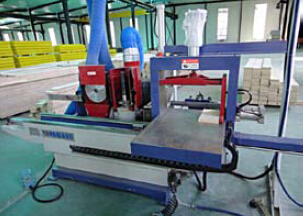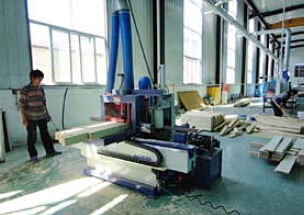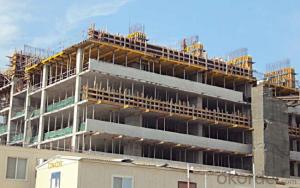Timber Beam Formwork H20 for formwork and scaffolding system
- Loading Port:
- Tianjin
- Payment Terms:
- TT OR LC
- Min Order Qty:
- 50 m²
- Supply Capability:
- 1000 m²/month
OKorder Service Pledge
Quality Product, Order Online Tracking, Timely Delivery
OKorder Financial Service
Credit Rating, Credit Services, Credit Purchasing
You Might Also Like
Characteristics:
◆ Standardized production lines.
Supply capability: 3000m/day, Lmax = 6600mm.
◆ Finger jointing of the flange and web, the strength of timber beam is highly improved.
Max. shearing force failure load:40KN
◆ Well treated to prevent from water penetration or erosion, so the service life maximally
extended.
Normally, CNBM timber beam H20 can be used for 4 to 5 years, the exact using time would
depend on maintenance & storage.
◆ Robust caps at the end of the girders protect against damages.




- Q:Can steel formwork be used in high-rise construction projects?
- Indeed, high-rise construction projects can benefit from the utilization of steel formwork. With its versatility and durability, steel formwork proves to be an excellent choice for constructing concrete structures, especially in the realm of high-rise buildings. This option boasts various advantages, such as its exceptional strength, remarkable dimensional stability, and its ability to endure heavy loads and pressure. Moreover, steel formwork guarantees a smooth finish to the concrete surface and promotes environmental sustainability by allowing for easy reusability. Consequently, this minimizes material wastage and effectively reduces project costs. Furthermore, the adaptability of steel formwork systems enables customization to meet the specific requirements of high-rise construction projects, ultimately ensuring efficient and precise construction processes.
- Q:What is the process for installing steel formwork?
- The process for installing steel formwork typically involves the following steps: 1. Preparation: The site is cleared and leveled to ensure a smooth surface for the formwork installation. 2. Measurement and marking: The dimensions and layout of the formwork are measured and marked on the ground or existing structure. 3. Assembly: The steel formwork panels, which are designed to interlock, are assembled according to the marked dimensions. The panels are secured together using various connecting methods, such as bolts, clamps, or pins. 4. Alignment and leveling: The formwork is aligned and leveled using leveling devices, such as spirit levels or laser levels. This ensures that the formwork is perfectly straight and even. 5. Reinforcement placement: If required, steel reinforcement bars are placed within the formwork to strengthen the concrete structure. 6. Bracing and support: Additional bracing and support are installed to reinforce the formwork and prevent any movement during the concrete pouring process. 7. Concrete pouring: Once the formwork is in place and properly secured, concrete is poured into the formwork, filling the desired shape or structure. 8. Curing and removal: After the concrete has cured, the formwork is removed carefully to avoid damaging the newly formed structure. The removed formwork can be cleaned and reused for future projects if it is in good condition. It's important to note that the specific process may vary depending on the project requirements, design, and the type of steel formwork being used. Professional expertise and adherence to safety guidelines are essential during the installation process.
- Q:Can steel formwork be used for both small and large-scale concrete placements?
- Steel formwork is versatile and can be employed for concrete placements of any size. With its robustness and endurance, steel formwork is ideal for a range of construction endeavors. Its assembly and disassembly are effortless, enabling cost-effective utilization in both minor and major concrete placements. Moreover, steel formwork imparts a uniform and sleek finish to the concrete surface, guaranteeing superior outcomes irrespective of the project's magnitude. Consequently, be it a petite residential construction or an expansive infrastructure venture, steel formwork proves to be a dependable option for concrete placements.
- Q:Can steel formwork be used for dam construction projects?
- Yes, steel formwork can be used for dam construction projects. Steel formwork offers several advantages such as high strength, durability, and the ability to withstand the weight and pressure of concrete. It provides a stable and secure framework for pouring and shaping the concrete structure of the dam. Additionally, steel formwork can be reused multiple times, making it cost-effective for large-scale projects like dam construction.
- Q:Can steel formwork be used for bridge construction projects?
- Yes, steel formwork can be used for bridge construction projects. Steel formwork is a versatile and durable solution that is often preferred for bridge construction due to its high strength and load-bearing capacity. It provides a sturdy framework that can withstand the weight and pressure exerted by concrete during the construction process. Steel formwork offers several advantages for bridge construction projects. Firstly, it can be easily customized and fabricated to the desired shape and size, allowing for precise and efficient construction. Additionally, steel formwork can be reused multiple times, making it a cost-effective option for bridge construction projects. Furthermore, the use of steel formwork ensures a smooth and uniform finish on the bridge structure, resulting in a high-quality end product. Steel formwork also allows for the integration of various features, such as recesses and openings, which can be essential for bridge construction. Overall, steel formwork is a suitable choice for bridge construction projects due to its strength, durability, and ability to provide a precise and uniform finish.
- Q:How does steel formwork handle concrete vibration and air entrapment?
- Steel formwork is highly effective in handling concrete vibration and minimizing air entrapment during the pouring and curing process. Firstly, steel formwork is known for its high strength and rigidity, which allows it to withstand the intense vibrations caused by concrete compaction. When concrete is poured into steel formwork, the formwork itself acts as a barrier, preventing excessive movement or deformation that could lead to the formation of voids or air pockets. This ensures that the concrete is evenly distributed and compacted throughout the structure. Additionally, steel formwork is designed with tight joints and smooth surfaces, which helps in reducing air entrapment. The joints are tightly sealed to prevent any leakage, which could result in air being trapped within the concrete. This is particularly important as air pockets can weaken the structural integrity and durability of the concrete. The smooth surfaces also aid in the easy flow and consolidation of the concrete, reducing the chances of air entrapment. Furthermore, steel formwork can be easily customized and adjusted to fit the specific requirements of the construction project. This allows for precise and accurate placement of the formwork, ensuring that the concrete is poured and compacted in the desired manner. By having complete control over the formwork, the risk of air entrapment can be minimized, resulting in a more durable and reliable concrete structure. In conclusion, steel formwork is an excellent choice for handling concrete vibration and air entrapment. Its strength, rigidity, tight joints, and smooth surfaces provide the necessary stability and control during the pouring and compaction process. By using steel formwork, construction professionals can ensure that the concrete is properly consolidated and free from air pockets, resulting in a high-quality and long-lasting structure.
- Q:How does steel formwork affect the overall project budget?
- Steel formwork can have a significant impact on the overall project budget. While steel formwork may have a higher initial cost compared to other types of formwork, such as timber or plywood, it offers several advantages that can ultimately lead to cost savings. One of the main advantages of steel formwork is its durability. Steel is a strong and long-lasting material, capable of withstanding the wear and tear of multiple uses. This means that steel formwork can be reused for numerous projects, reducing the need for frequent replacements and lowering costs in the long run. Furthermore, steel formwork allows for faster construction times. Its robustness and stability enable contractors to pour concrete at a faster rate, reducing labor costs and streamlining the construction process. Additionally, steel formwork can be easily assembled and disassembled, resulting in quicker turnaround times between projects. In terms of quality, steel formwork ensures a high level of precision and consistency in concrete structures. This can minimize the need for rework and corrections, thus reducing costs associated with fixing errors or imperfections. Moreover, steel formwork offers flexibility in design. It can be customized to fit various shapes and sizes, allowing for greater architectural freedom and creativity. This versatility can contribute to cost savings by eliminating the need for expensive and complex modifications to the formwork system. Finally, steel formwork is known for its resistance to moisture and weather conditions. Unlike timber or plywood, steel does not warp or deteriorate when exposed to moisture, which can result in cost savings by avoiding replacements or repairs due to water damage. In summary, while steel formwork may have a higher initial cost, its durability, reusability, speed, precision, flexibility, and resistance to environmental factors can lead to overall cost savings throughout the project. By considering the long-term benefits and efficiencies offered by steel formwork, project budgets can be effectively managed and optimized.
- Q:Can steel formwork be easily transported to different job sites?
- Indeed, steel formwork can effortlessly be transported to various worksites. Renowned for its sturdiness and robustness, steel formwork is ideal for repeated utilization and convenient transportation. It can be dismantled and reassembled without compromising its structural soundness, enabling effortless transportation to diverse destinations. Furthermore, unlike alternative formwork types, steel formwork is lightweight, rendering it more manageable to handle and transport using conventional construction machinery or vehicles. The adaptability and portability of steel formwork render it an esteemed preference for construction ventures necessitating frequent relocation between worksites.
- Q:Are there different sizes of steel formwork available?
- Indeed, a variety of sizes of steel formwork can be found. Steel formwork, a versatile construction material, sees extensive use in a multitude of building endeavors. Its inherent strength, durability, and stability render it well-suited for diverse applications. Customization of steel formwork to match specific project demands facilitates the creation of various shapes and structures, enabling flexibility. Moreover, the utilization of steel formwork facilitates efficient construction procedures, owing to its effortless assembly and disassembly, rendering it suitable for projects of all scales, be they small or large.
- Q:How does steel formwork affect the quality of concrete?
- Steel formwork can greatly affect the quality of concrete by providing a stable and precise mold for the concrete to be poured into. The use of steel formwork helps ensure uniformity in shape, size, and surface finish of the concrete, resulting in a higher quality and more consistent end product. The strength and durability of steel formwork also enable it to withstand the pressure exerted by the wet concrete, preventing any deformation or leakage that could compromise the integrity of the concrete structure.
1. Manufacturer Overview |
|
|---|---|
| Location | |
| Year Established | |
| Annual Output Value | |
| Main Markets | |
| Company Certifications | |
2. Manufacturer Certificates |
|
|---|---|
| a) Certification Name | |
| Range | |
| Reference | |
| Validity Period | |
3. Manufacturer Capability |
|
|---|---|
| a)Trade Capacity | |
| Nearest Port | |
| Export Percentage | |
| No.of Employees in Trade Department | |
| Language Spoken: | |
| b)Factory Information | |
| Factory Size: | |
| No. of Production Lines | |
| Contract Manufacturing | |
| Product Price Range | |
Send your message to us
Timber Beam Formwork H20 for formwork and scaffolding system
- Loading Port:
- Tianjin
- Payment Terms:
- TT OR LC
- Min Order Qty:
- 50 m²
- Supply Capability:
- 1000 m²/month
OKorder Service Pledge
Quality Product, Order Online Tracking, Timely Delivery
OKorder Financial Service
Credit Rating, Credit Services, Credit Purchasing
Similar products
New products
Hot products
Related keywords























